Pierre Clostermann
La guerre de Clostermann
Clostermann's war
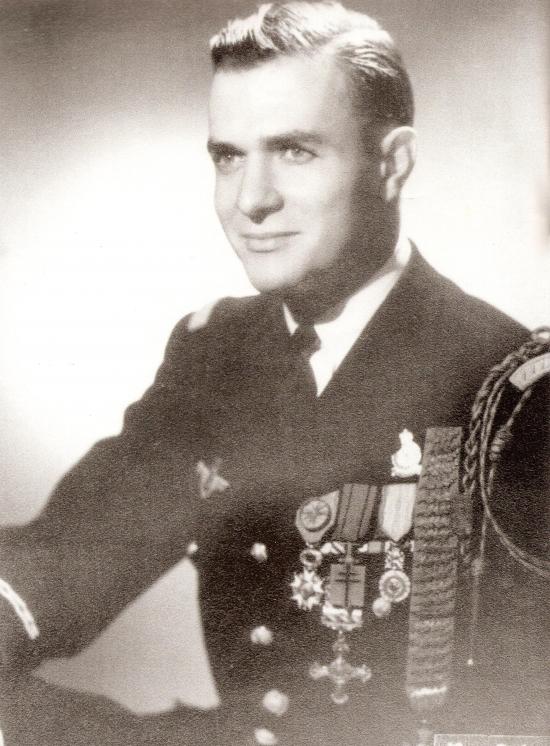
Pierre Clostermann est né le 28 février 1921 à Curitiba, Brésil, où son père, Jacques, est diplomate. Il découvre l’aviation à 4 ans en lorsque son père l’emmène voir un Latécoère de l’Aéropostale sur la plage de Guaruja à Santos. Puis, il reste en France en pension chez son oncle Robert Aubry, ancien pilote de la grande guerre ; c’est pendant cette période qu’il lit les récits sur Guynemer, Navarre et Fonck. A 14 ans, en été 1935, Pierre Clostermann reçoit son baptême de l'air sur l'hydravion Latécoère Lieutenant de Vaisseau Paris sur l'étang de Biscarosse.
Pierre Clostermann was born on February 28th, 1921 to Curitiba, Brazil, where his father, Jacques, is a diplomat. He discovers the aviation at 4 years when his father takes him to see a Latécoère of the Aéropostale on the beach of Guaruja at Santos. Then, he remains in France with his uncle Robert Aubry, a WWI ancient pilot ; during this period, he reads books Guynemer, Navarre and Fonck. He is aged 14 when, in summer 1935, Pierre Clostermann receives his first flight on the seaplane Latécoère Lieutenant de Vaisseau Paris on the lake of Biscarosse.
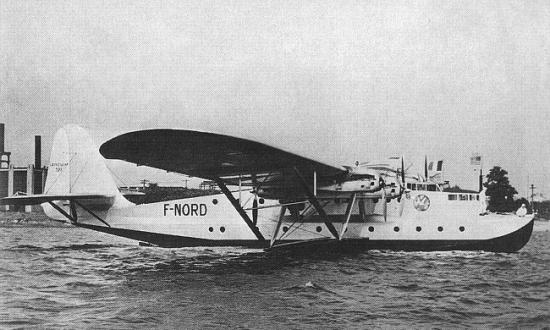
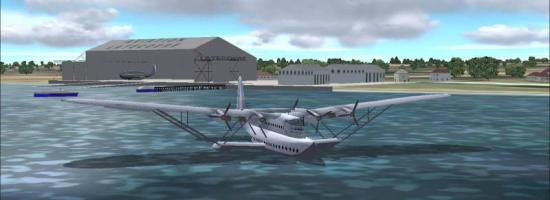 Latécoère 521 "Lieutenant de Vaisseau Paris
Latécoère 521 "Lieutenant de Vaisseau Paris
A 16 ans il retourne chez ses parents et apprend à piloter sur Bücker Jungmann ; le 27 novembre 1937, il obtient son brevet de pilote à l'aéroclub du Brésil à Manguinhos. Son instructeur était un allemand, Karl Benitz, qui fut tué en vol durant la guerre de 39-45.

2 years later, he returns at his parent's and learns to pilot on Bücker Jungmann ; on November 27th, 1937, he obtains his pilot's licence in the airclub of Brazil at Manguinhos. His German instructor, Karl Benitz, was killed in flight during WWII.
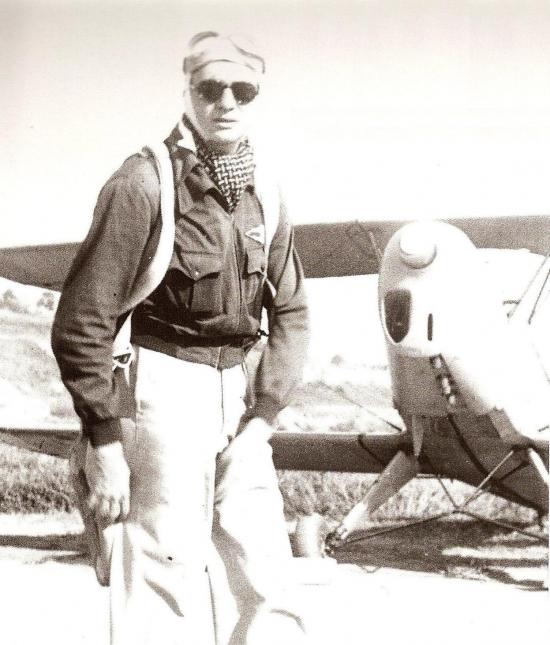 Clostermann devant son Bücker à Manguinhos en 1937
Clostermann devant son Bücker à Manguinhos en 1937
Clostermann in front of his Bücker at Manguinhos in 1937.
Ayant obtenu une bourse de la Pan American Airways, Pierre Clostermann part aux Etats-Unis en 1938 et devient élève ingénieur au Ryan College du California Technical Institute (San Diego) pour passer le diplôme de pilote commercial et d’ingénieur aéronautique qu’il obtient en 1940.
With a grant of Pan American Airways, Pierre Clostermann leaves to the United States in 1938 and becomes a student engineer to the Ryan College of the California Technical Institute (San Diego) to get the diploma of private pilot and aeronautical engineer : he obtains it in 1940.
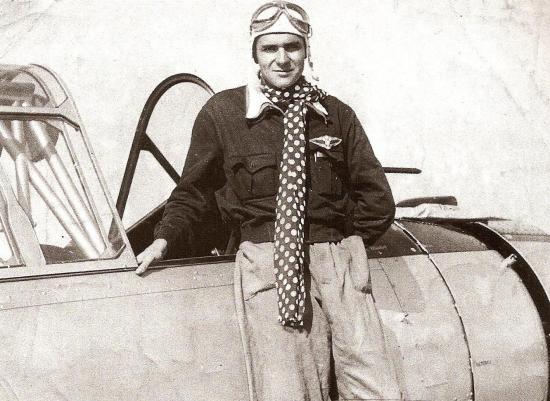 Devant un North American AT-6 au CALTEC - In front of a North American AT-6 at the CALTEC.
Devant un North American AT-6 au CALTEC - In front of a North American AT-6 at the CALTEC.
Choqué par l’effondrement de la France en 1940, et encouragé par son père qui est parti rejoindre de Gaulle avec le Général Valin, Pierre Clostermann rejoint l'Angleterre, via Miami en Floride (en DC-3 d’Eastern Airlines), le Brésil (en hydravion Sikorsky de la Panam), l'Uruguay et l'Afrique du Sud (à bord du MV Rangitata), pour s'engager dans les Forces Aériennes Françaises Libres (FAFL) le 18 mars 1942 (matricule 30 973) où ses 315 heures de vol lui vaudront d’être promu sergent.
Shocked by the collapse of France in 1940, and encouraged by his father who left to join de Gaulle with the General Valin, Pierre Clostermann joins England, via Miami in Florida (in a DC-3 of Eastern Airlines), Brazil (in seaplane Sikorsky of the Panam), Uruguay and South Africa (aboard the MV Rangitata), to commit himself in the Free French Air forces ( FAFL) on March 18th, 1942 (roll 30 973) where his 315 hours of flight will be worth to him being promoted sergeant.
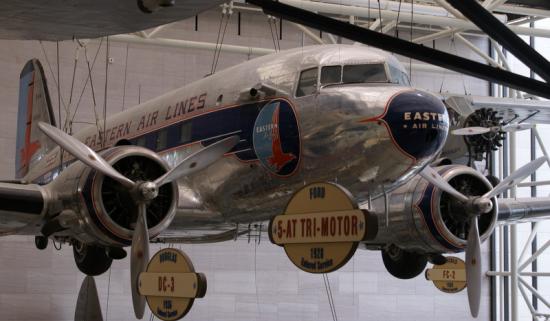 Un DC-3 d'Eastern Airlines - An Eastern Airlines DC-3
Un DC-3 d'Eastern Airlines - An Eastern Airlines DC-3
Les premiers tests d’aptitude s’effectuent sur Tiger Moth à Sywell et sur Miles Master à Aston Down : il est noté "Above average" (au-dessus de la moyenne). Il refuse ensuite un poste d’instructeur en Rhodésie et au Canada et est sélectionné pour suivre les cours d'élève-officier au RAF College de Cranwell : il s’y perfectionne sur Miles Master et sort 1er avec une note de 100/100.

De Havilland Tiger Moth Miles Master
The first aptitude tests are made on Tiger Moth at Sywell and on Miles Master at Aston Down: he is noted " Above average ". He then refuse an instructor's post in Rhodesia and Canada and is selected to attend officer's trainings at the RAF COLLEGE of CRANWELL: there, he perfects on Miles Master and exits first with a note of 100/100.
 A Cranwell devant des Miles Master. At Cranwell in front of Miles Master.
A Cranwell devant des Miles Master. At Cranwell in front of Miles Master.
En Novembre 1942, Pierre Clostermann est affecté à l'Operational Training Unit 61 de Rednal (Pays de Galles). Il effectue son premier vol sur Spitfire (matricule TO-S). C’est là qu’il retrouve celui qui deviendra son meilleur ami, Jacques Remlinger (il l’avait croisé à Sywell).
In November, 1942, Pierre Clostermann is allocated to Operational Training Unit 61 at Rednal (Wales). He makes his first flight on Spitfire (code TO-S). It is there that he meets again the one who will become his best friend, Jacques Remlinger (he had crossed him at Sywell).
 Jacques Remlinger Pierre Clostermann
Jacques Remlinger Pierre Clostermann
Le 21 janvier 1943, Clostermann est affecté au 341 (Free French) Squadron – allias GC III/2 « Alsace », dirigé par René Mouchotte, composé uniquement de Français Libres et basé à Turnhouse (Écosse) puis à partir du 20 mars 1943 à Biggin-Hill (Angleterre). Clostermann est affecté au « A » flight de Christian Martell.
On January 21st, 1943, Clostermann is allocated to the 341 (Free French ) Squadron – the GC III /2 "Alsace", leaded by René Mouchotte, gathering only Free French people and based at Turnhouse (Scotland) and then from March 20th, 1943 at Biggin-Hill (England). Clostermann is allocated to the flight "A" of Christian Martell.
 "Alsace"
"Alsace"
Sa première sortie a lieu le 24 mars pour un vol de reconnaissance sur le Spitfire NL-D, puis la seconde sur alerte à bord du NL-E le 28 mars, suivie d’une patrouille sur celui qui deviendra son avion personnel, le NL-B (serial BS538). Le 12 mai 1943, Clostermann est abattu au-dessus de la Manche par un Messerschmitt 109. Il se parachute sans dommage.
His first mission is on March 24th for a reconnaissance flight on Spitfire NL-D, then the second on alert aboard the NL-E on March 28th, followed by a patrol on the one who will become his personal plane, the NL-B (serial BS538). May 12th, 1943, Clostermann is shot down over the Channel by a Messerschmitt 109. He parachutes without damage.
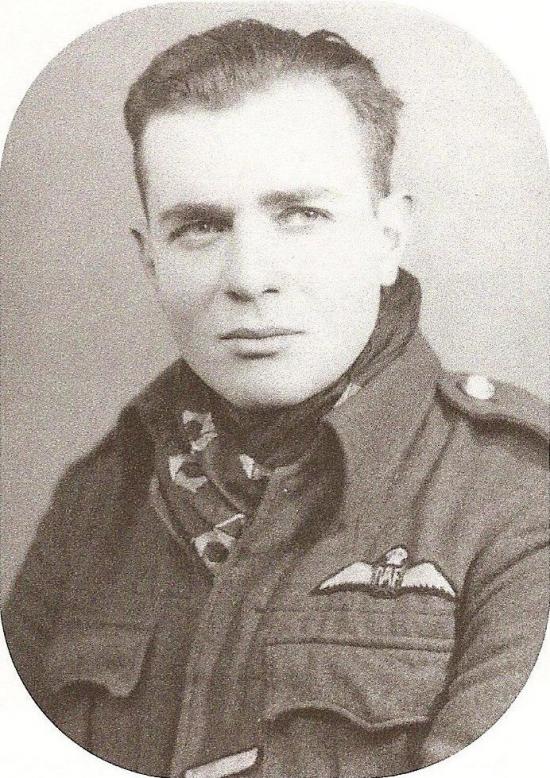
Le premier avion allemand qui lui est accordé est un Me 109 « endommagé » le 17 mai 1943 lors d’un « sweep » sur Rouen dans le cadre du « Circus 299 ».Le 15 juillet, il se pose roues rentrées sur le Spitfire LN-H au retour d’une mission d’escorte. Le 27 juillet 1943 : deux premières victoires du sergent-chef Pierre Clostermann en combat aérien sur des Focke-Wulf 190 du JG2 à 18h40 au dessus de Trouville en Normandie. Le 27 août 1943, jour de la disparition du commandant du groupe Alsace, René Mouchotte, Pierre Clostermann, alors son ailier, remporte sa 3ième victoire confirmée (Focke-Wulf 190). Suite à cette sortie, le commandant Dupérier suspends Clostermann de vol pour « abandon de son leader ». Il est ensuite affecté au 602 Squadron du 125 Wing. Auparavant, et à l’occasion de son dernier vol au groupe « Alsace », il abat un Messerschmitt 109 G (finalement qualifié de « probable ») le 25 septembre 1943 (mission de calibrage de radars anglais). Il aura effectué 176 vols au sein de « l’Alsace ».
The first German plane which is granted to him is one Me 109 "damaged" on May 17th, 1943 during a "sweep" on Rouen (" Circus 299 "). On July 15th, he lands with wheels in on Spitfire LN-H when returning from an escort mission. July 27th, 1943 : first two victories allocated to the chief-sergeant Pierre Clostermann in air combat on Focke-Wulf 190s of the JG2 at 6:40 pm above Trouville in Normandy. On August 27th, 1943, day of the disappearance of the commander of the group Alsace, René Mouchotte, Pierre Clostermann, then his winger, obtains his 3rd confirmed victory (Focke-Wulf 190). Further to this mission, the commander Dupérier suspends Clostermann of flight for " abandonment of his leader ". He is then allocated to 602 Squadron of 125 Wing. Previously, and on the occasion of his last flight with the group " Alsace ", he shoots down a Messerschmitt 109 G (finally considered as "probable") on September 25th, 1943 (mission of grading of English radars). He has made 176 flights among the "Alsace".
26 septembre 1943, Pierre Clostermann rejoint le « A Flight » du groupe de chasse 602 City of Glasgow où se trouve déjà son ami Jacques Remlinger. Il pilote un Spitfire immatriculé LO-D mais c’est sur le Spitfire LF IXF « LO-Q » qu’il revendique un FW 190 endommagé le 16 octobre 1943 lors d’une reconnaissance météo sur Blankenberge (Ostende). Le 7 janvier 1944, lors du Ramrod 433, une mission de protection de « Forteresses Volantes », il revendique un FW 190 endommagé à bord du Spitfire LF IXC « LO-K » (LH504) à l’est d’Abbeville. Puis l’escadron part au repos dans les îles Orcades. Clostermann y effectue un atterrissage train rentré le 7 mars sur le vieux Spitfire LF VB « LO-D » (BL686). 12 mars 1944, l’unité retourne à Detling puis effectue un stage de 3 semaines au nord du Pays de Galles pour apprendre le bombardement en piqué en vue de l’attaque des bases de V-1.
In September 26th, 1943, Pierre Clostermann joins the "A Flight" of the fighter group 602 City of Glasgow where his friend Jacques Remlinger already is. He pilots the Spitfire LO-D but it’s on the Spitfire LF IXF "LO-Q" that he claims a FW 190 damaged on October 16th, 1943 during a meteorological recognition on Blankenberge (Ostend). On January 7th, 1944, during Ramrod 433, a mission of protection of "Flying Fortresses", he claims a FW 190 damaged aboard the Spitfire LF IXC " LO-K " ( LH504) east of Abbeville. Then the squadron leaves to rest on Orcades islands. Clostermann makes a landing wheels in on March 7th on the old Spitfire LF VB "LO-D" ( BL686). In March 12th, 1944, the unit returns to Detling to make a training course of 3 weeks in Northern Wales to learn diving bombardment with the aim of attacking V-1 bases.
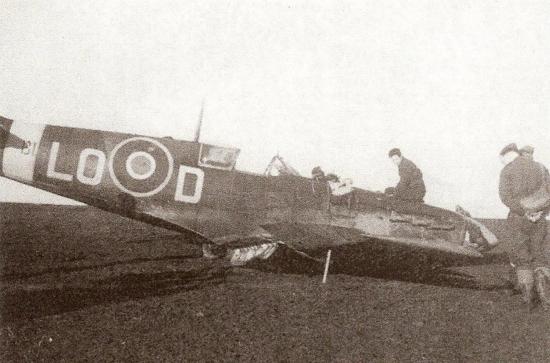
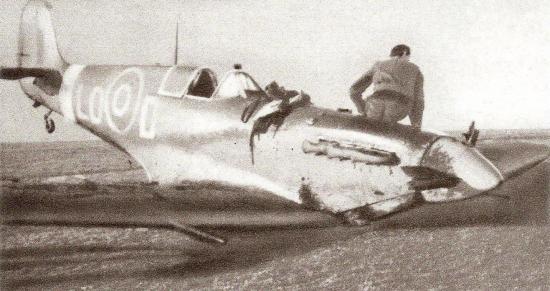
L’unité retourne à Ford dans le Sussex en avril 1944. 11 juin 1944, pour la première fois depuis le début de la guerre, Pierre Clostermann se pose en France sur le terrain de Bazenville (B2). Le 15 juin Clostermann et Remlinger mitraillent le terrain de Saint-André de l’Eure et Clostermann revendique un Bf 109 en train de se poser : il volait à bord du Spitfire LF IXC MK611. Le 26 juin 1944, Clostermann s’octroie à bord du MK250 une victoire probable sur un Bf 109 G et une sûre sur un FW 190 ce qui fera de lui ce jour là un « as ». Le 29 juin, il abat un FW 190 (sans doute de la 2./NAGr 13) à bord du Spitfire LF IXC serial MJ586 « LO-D » et le lendemain un Bf 109 « probable ». Le 2 juillet, sur alerte à bord du MJ305, il revendiquera un FW 190 « sûr », un « probable » et trois « endommagés ».
The unit returns to Ford in Sussex in April, 1944. In June 11th, 1944, for the first time since the beginning of the war, Pierre Clostermann comes back in France on the airfield of Bazenville (B2). On June 15th Clostermann and Remlinger machine-guns the ground of Saint André de l' Eure and Clostermann claims a Bf 109 which was landing : he flew aboard the Spitfire LF IXC MK611. On June 26th, 1944, Clostermann grants himself aboard the MK250 a “probable” victory on a Bf 109 G and a confirmed victory on a FW 190 which will make him become an “ace" this day. On June 29th, he shoots down a FW 190 (probably belonging to the 2. / NAGr 13) aboard the Spitfire LF IXC serial MJ586 "LO-D" and the next day a “probable” Bf 109. On July 2nd, on alert aboard the MJ305, he will claim a "confirmed" FW 190, a "probable" and three "damaged".
Le 6 juillet 1944, Pierre Clostermann se voit accordé la Distinguished Flying Cross (DFC) pour avoir détruit au moins 11 avions. Le 7 juillet 1944, après l'équivalent de deux tours d'opérations, et près de 600 jours en opération, il est envoyé au repos en Angleterre. A la demande de Charles de Gaulle, il est inscrit sur la liste des pilote des FAFL que le Général veut empêcher de retourner au combat. Il a obtenu 11 victoires confirmées (sur Spitfire). Après sa permission, en septembre 1944, Pierre Clostermann part suivre les cours de la Central Gunnery School de Catfoss.
On July 6th, 1944, Pierre Clostermann is granted of the Distinguished Flying Cross (DFC) for his 11air victories. On July 7th, 1944, after the equivalent of two tours of operations, and about 600 days in operation, he is sent to have rest in England. At the request of Charles de Gaulle, he is registered on the list of pilots of the FAFL whom the General wants to prevent from returning to the combat. He obtained 11 confirmed victories (on Spitfire). After his permission, in September, 1944, Pierre Clostermann attends a training at the Central Gunnery School at Catfoss.
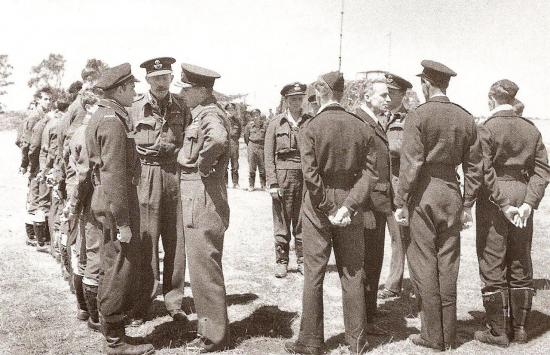 Pierre Clostermann reçoit la Distinguished Flying Cross.
Pierre Clostermann reçoit la Distinguished Flying Cross.
Pierre Clostermann is granted of the Distinguished Flying Cross.
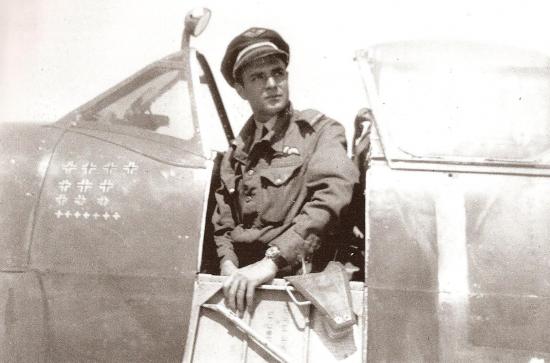
Juillet 1944 - July 1944
Janvier 1945 : après quelques mois passés au service de presse des Forces Aériennes Françaises Libres à Londres (en compagnie en particulier de l'écrivain Romain Gary), Pierre Clostermann demande sa réintégration dans une unité opérationnelle. Il est affecté tant bien que mal le 17 février 1945 comme Flight Lieutenant au 122 Wing, (basée en Hollande à Volkel). Ce même jour, il effectuera son premier vol sur Hawker Tempest Mk V Series 2 immatriculé JJ-B (il a au préalable effectué sa transformation à la 55 OTU d’Aston Down sur Typhoon puis Tempest).
January, 1945 : after some months spent at the press service of the Free French Airforce in London (with the writer Roman Gary), Pierre Clostermann asks for his comeback to an operational unit. He is hardly allocated on February 17th, 1945 as Flight Lieutenant to 122 Wing, (based in Holland at Volkel). The same day, he will fly for the first time on Hawker Tempest Mk V Series 2 JJ-B (he made his conversion in 55 OTU at Aston Down on Typhoon and then on Tempest).
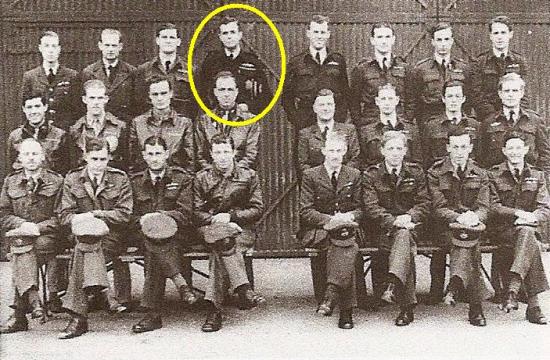 Aston Down - 55 OTU
Aston Down - 55 OTU

Wing 122
Entretemps, le 14 janvier 1945, Bruno Klostermann, cousin allemand éloigné de Pierre Clostermann, est abattu aux commandes de son Messerschmitt 109. Le 2 mars, « Cloclo » est affecté au 274 Squadron. Le 5 mars, il s’envole à bord du « JJ-W » (EJ893) pour un « essai d’armement » et revendique une victoire sur un Me 109 dans le secteur Hengelo-Nordhorn.
In the meantime, on January 14th, 1945, Bruno Klostermann, Pierre Clostermann’s German cousin, is shot down on his Messerschmitt 109. On March 2nd, "Cloclo" is allocated to 274 Squadron. On March 5th, he flies aboard the "JJ-W" (EJ893) for an "armament trial" and claims a victory on a Me 109 in the sector Hengelo-Nordhorn.
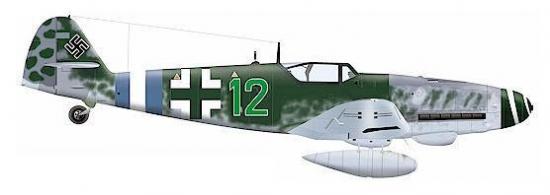 Messerschmitt Bf 109 G-10 - II./JG 300 - Bruno Klostermann
Messerschmitt Bf 109 G-10 - II./JG 300 - Bruno Klostermann
(artiste inconnu - artist unknown)
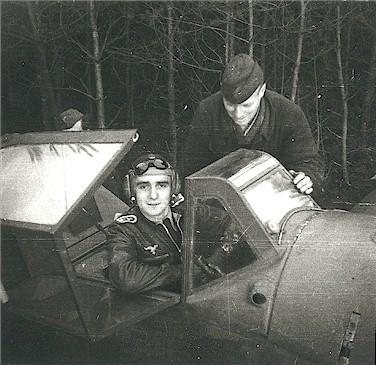
Bruno Klostermann
cousin allemand de Pierre Closterman
Pierre Clostermann's German cousin
Le 17 mars 1945, « Cloclo » est transféré au 56 Squadron. Le 28 mars, il revendique un Fieseler Storch au sol au sud de Munster sur le NV970 « US-O ». Le 24 mars 1945, Pierre Clostermann est touché par la flak et doit se poser sur le ventre. Le 2 avril 1945, il effectue à bord du Tempest NV968 « US-G » sa dix-septième mission de guerre ; il revendique une victoire sur un FW 190 D-9.
On March 17th, 1945, "Cloclo" is transferred to 56 Squadron. On March 28th, he claims a Fieseler Storch on the ground in the South of Munster on the NV970 "US-O ". On March 24th, 1945, Pierre Clostermann is hit by the flak and has to land wheels in. On April 2nd, 1945, he makes aboard Tempest NV968 " US-G " his seventeenth war mission ; he claims a victory on a FW 190 D-9.
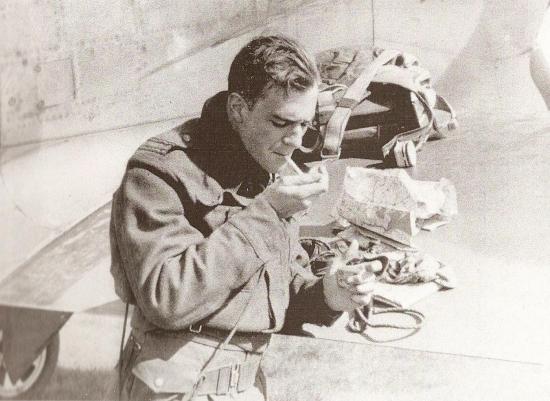 Retour de mission (Mars 1945) - Return of mission (March 1945)
Retour de mission (Mars 1945) - Return of mission (March 1945)
Le 5 avril, il endommage deux autres FW 190 à bord du Tempest EJ536 « US-W ». Le 8 avril 1945, Pierre Clostermann est affecté au groupe de chasse 3. Il pilote un Tempest immatriculé JF-E (NV994 - Le Grand Charles) et commande le « A » flight. Le 20 avril, il abat à son bord deux FW 190. Blessé à l’atterrissage au retour de cette mission, il ne retrouve son unité le 3 mai et retrouve un « JF-E » immatriculé SN-222. Le 27 avril 1945, Pierre Clostermann est nommé commandant de l'escadre de chasse 122.
On April 5th, he damages two other FW 190 aboard the Tempest EJ536 "US-W ". On April 8th, 1945, Pierre Clostermann is allocated to the fighter group 3. He pilots the Tempest JF-E (NV994 – Le Grand Charles) and leads the flight "A". On April 20th, he shoots down two FW 190. Injured when landing on the return of this mission, he comes back in his unit on May 3rd and finds a "JF-E" SN-222.
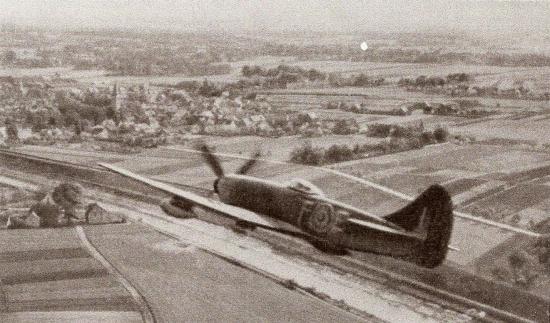
 Le premier "JF-E" (NV994) - The first "JF-E" (NV994)
Le premier "JF-E" (NV994) - The first "JF-E" (NV994)
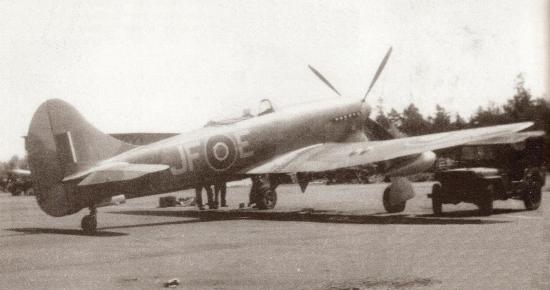

"JFE" "Le Grand Charles" (SN-222)
Puis le 3 mai 1945, lors d'une attaque de la base de Großenbrode, il abat successivement cinq avions (un Blohm & Voss 138, un Junkers 252, deux Dornier 24 et un Messerschmitt 109). Le 8 mai 1945, Pierre Clostermann termine la guerre avec 33 victoires Mais le 12 mai 1945, lors d'un défilé aérien au-dessus de Bremenshaven, les quatre avions de sa section se percutent et Pierre Clostermann est le seul pilote à en réchapper. Le 27 août 1945 enfin, Pierre Clostermann est démobilisé.
Then on May 3, 1945, during the attack of the base of Großenbrode, it shoots down successively five planes (Blohm & Voss 138, Junkers 252, two Dornier 24 and one Messerschmitt 109). On May 8, 1945, Pierre Clostermann finishes the war with 33 victories. But on May 12, 1945, during an airexhibition above Bremenshaven, the four planes of his section strike and Pierre Clostermann is the only pilot to escape. On August 27, 1945, Pierre Clostermann is finally demobilized.
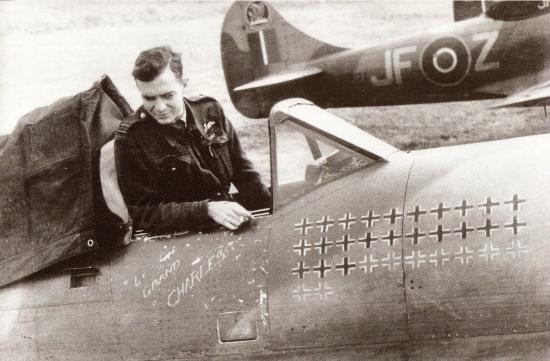 "Le Grand Charles" - Juin 1945 - June 1945
"Le Grand Charles" - Juin 1945 - June 1945
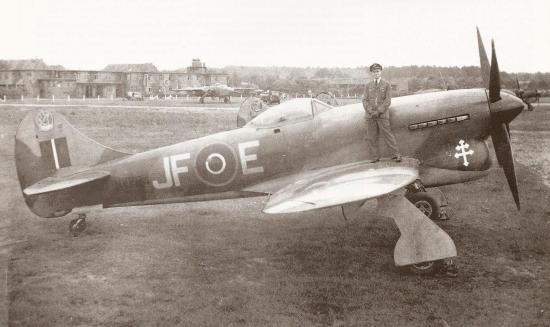
"JF-E" (NV724) - 27 Août 1945 - 27th August, 1945.
 Officier de la Légion d'Honneur - Officer of the "Légion d'Honneur"
Officier de la Légion d'Honneur - Officer of the "Légion d'Honneur"
Après la guerre, Pierre Clostermann est rappelé pour servir en Algérie en 1956 et 1957. Il devient ensuite Directeur Adjoint puis PDG de la société Reims Aviation dans les années 60 à 80. Pierre Clostermann décéde le 22 mars 2006.
After the war, Pierre Clostermann is recalled to go to the Algerian war in 1956 and 1957. Then he becomes General Manager and later Chairman of the company Reims Aviation in the Sixties to Eighties. Pierre Clostermann dies on March 22, 2006. 
Les avions de Clostermann
Clostermann's aircrafts

Supermarine Spitfire F IXC "NL-B" (BS538) - 341 Sqn, Biggin Hill.
Avril et Juillet 1943 - April and July, 1943.
© Dekker Art Work (Thierry Dekker) : http://dekker-artwork.blogspot.fr

Supermarine Spitfire Mk IXB "LO-Q" (MH512)
602 Sqn, Detling - Octobre - novembre 1943 - October - November 1943.
© Dekker Art Work (Thierry Dekker) : http://dekker-artwork.blogspot.fr

Supermarine Spitfire LF IXC "LO-D" (MH526)
602 Sqn, Ford - Printemps 1944 - Spring 1944.
© Dekker Art Work (Thierry Dekker) : http://dekker-artwork.blogspot.fr

Supermarine Spitfire LF IXC "LO-D" (MH526)
602 Sqn, Ford - 6 juin 1944 - 6th June 1944.
© Dekker Art Work (Thierry Dekker) : http://dekker-artwork.blogspot.fr

Supermarine Spitfire LF VB "LO-D" (BL686)
602 Sqn, Skeabrae (Iles Orcades) - 7 mars 1944 - (Orcades islands)- 7th March, 1944.
© Dekker Art Work (Thierry Dekker) : http://dekker-artwork.blogspot.fr

Supermarine Spitfire LF VB "LO-V" (EP767) - 602 Sqn, Skeabrae
(Iles Orcades) - accidenté par Clostermann le 7 mars 1944 - (Orcades islands)- Damaged by Clostermann on 7th March, 1944.
© Dekker Art Work (Thierry Dekker) : http://dekker-artwork.blogspot.fr
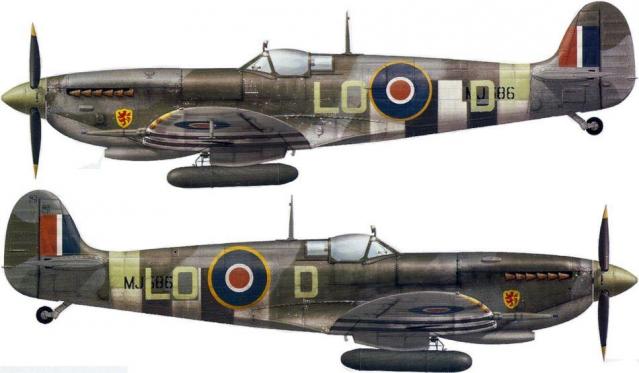
Supermarine Spitfire LF IXC "LO-D" (MJ586)
602 Sqn, Longues-sur-Mer (ALG B.11) juillet 1944 - July, 1944.
© Dekker Art Work (Thierry Dekker) : http://dekker-artwork.blogspot.fr





